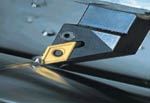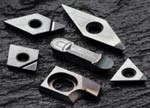PCD Tools Get Tough
Contrary to their reputation as tools reserved strictly for finish machining of non-ferrous metals, some polycrystalline diamond (PCD) cutting tools now possess the durability to handle a much wider range of applications.
Contrary to their reputation as tools reserved strictly for finish machining of non-ferrous metals, some polycrystalline diamond (PCD) cutting tools now possess the durability to handle a much wider range of applications. As the utilization of aluminum-based parts continues to grow—particularly in automotive manufacturing—the performance of PCD tooling has become a more significant issue. In turn, this has produced strong, recent growth in the worldwide market for PCD tools.
Although cutting tools represent only a small percentage of the total cost to manufacture a specific part, the costs to interrupt production for frequent tool changes are substantial. Conventional PCD tools cannot withstand the wide variations in cutting force that are typical of rough-machining operations. Under these conditions, cutting edges chip readily, and tool consumption is unacceptably high. Chipping of the cutting edge commonly occurs during the initial stage of an interrupted machining process. As these chips accumulate, surface smoothness of the workpiece degrades and burring increases. For these reasons, cemented carbide tools are commonly used for milling and rough cutting of aluminum alloys.
The composition of conventional PCD tools derives from the sintering process by which they are manufactured. Because this process yields unbalanced distributions of diamond particles and a ferrous metal catalyst (primarily cobalt), an inverse relationship exists between wear resistance and strength in the tool. Coarse grades of PCD tools (containing larger diamond particles) are the most wear-resistant types, but they also have the least strength and toughness. Conversely, fine grades of PCD tools are very tough, but wear resistance is poor. Because of this performance trade-off, medium grades of conventional PCD tools are typically used to machine aluminum parts. But these tools can only provide median levels of toughness and wear-resistance.
To address these limitations, Sumitomo Electric Carbide, Inc. (Mt. Prospect, Illinois) has developed the Sumidia DA2200 line of high-strength PCD cutting tools. The proprietary manufacturing process for these tools produces uniform distribution of extremely fine diamond particles. This gives the tools a combination of substantial wear resistance and toughness (defined as “transverse rupture strength”). The result is a cutting edge with sufficient durability to handle rough and interrupted machining of various aluminum alloys and other non-ferrous metals.
Sumitomo has tested its new line of PCD tools under a variety of machining conditions. In milling and rough-cutting tests using an aluminum alloy workpiece, the performance of these tools is equivalent to cemented carbide tools. In continuous cutting tests, the DA2200 tools demonstrate wear resistance equivalent to conventional, medium-grade PCD tools.
Based on four typical machining applications for aluminum alloy parts, Sumitomo compared the performance of its improved PCD tools to conventional PCD and cemented carbide tools. In the facemilling of automotive cylinder heads, as well as endmilling of base plates for hard disk drives, the DA2200 tools demonstrated life spans up to three times longer than conventional PCD tools. When rough cutting a die-cast aluminum transmission component, the tools lasted approximately 20 times longer than cemented carbide. Additionally, when turning aluminum alloy wheels for autos, the tools delivered up to 17 times the life of conventional PCD tools. One of the nation’s largest automotive wheel manufacturers recently tested the tools independently and achieved 12-14 times the life of its existing PCD tools.
The improved inserts are available in a wide range of geometries and edge preparations for various applications. Inserts that incorporate WF-type edge preparation, for example, can produce mirror-like surface finishes. The tools are also available with reinforced K- and H-type edge preparations to bolster cutting edge strength during severely interrupted machining. These tools are suitable for machining aluminum alloys incorporating up to 18 percent silicon content.
Related Content
How to Mitigate Chatter to Boost Machining Rates
There are usually better solutions to chatter than just reducing the feed rate. Through vibration analysis, the chatter problem can be solved, enabling much higher metal removal rates, better quality and longer tool life.
Read MoreNew Modular Tool Options for Small Spindle Milling
Tooling options have been limited for small spindle milling applications. Now modular, indexable systems are available that provide broad flexibility to get the right cutter for the job with less inventory and at lower cost.
Read MoreChoosing Your Carbide Grade: A Guide
Without an international standard for designating carbide grades or application ranges, users must rely on relative judgments and background knowledge for success.
Read MoreA New Milling 101: Milling Forces and Formulas
The forces involved in the milling process can be quantified, thus allowing mathematical tools to predict and control these forces. Formulas for calculating these forces accurately make it possible to optimize the quality of milling operations.
Read MoreRead Next
3 Mistakes That Cause CNC Programs to Fail
Despite enhancements to manufacturing technology, there are still issues today that can cause programs to fail. These failures can cause lost time, scrapped parts, damaged machines and even injured operators.
Read MoreThe Cut Scene: The Finer Details of Large-Format Machining
Small details and features can have an outsized impact on large parts, such as Barbco’s collapsible utility drill head.
Read More















.png;maxWidth=300;quality=90)











